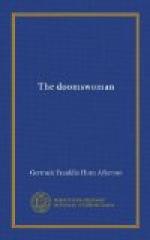The girls waltzed on the bare floor, grouped themselves in mock-dramatic postures, then, overcome by the strange magnetism of the singer, fell into motionless attitudes, listening intently. How well I remember that picture, although I have almost forgotten the names of the girls!
In the middle of the room two slender figures embraced each other, their black hair falling loosely over their white gowns. On the window-step knelt a tall girl, her head pensively supported by her hand, a black shawl draped gracefully about her; at her feet sat a girl with head bowed to her knees. Between the two groups was a solitary figure, kneeling with hand pressed to the wall and face uplifted.
When the voice ceased I struck a match, and five pairs of little hands applauded enthusiastically. He sang them another song, then galloped away.
“It is Don Diego Estenega,” said one of the girls. “He rarely sings, but I have heard him before.”
“An Estenega!” exclaimed Chonita.
“Yes; of the North, thou knowest. His Excellency thinks there is no man in the Californias like him,—so bold and so smart. Thou rememberest the books that were burned by the priests when the governor was a boy, because he had dared to read them, no? Well, when Diego Estenega heard of that, he made his father send to Boston and Mexico for those books and many more, and took them up to his redwood forests in the north, far away from the priests. And they say he had read other books before, although such a lad; his father had brought them from Spain, and never cared much for the priests. And he has been to Mexico and America and Europe! God of my soul! it is said that he knows more than his Excellency himself,—that his mind works faster. Ay! but there was a time when he was wild,—when the mescal burnt his throat like hornets and the aguardiente was like scorpions in his brain; but that was long ago, before he was twenty; now he is thirty-four. He amuses himself sometimes with the girls,—valgame Dios! he has made hot tears flow,—but I suppose we do not know enough for him, for he marries none. Ay! but he has a charm.”
“Like what does he look? A beautiful caballero, I suppose, with eyes that melt and a mouth that trembles like a woman in the palsy.”
“Ay, no, my Chonita; thou art wrong. He is not beautiful at all. He is rather haggard, and wears no mustache, and he has the profile of the great man, fine and aquiline and severe, excepting when he smiles, and then sometimes he looks kind and sometimes he looks like a devil. He has not the beauty of color; his hair is brown, I think, and his eyes are gray, and set far back; but how they flash! I think they could burn if they looked too long. He is tall and straight and very strong, not so indolent as most of our men. They call him The American because he moves so quickly and gets so cross when people do not think fast enough. He thinks like lightning strikes. Ay! they all say that he will be governor in his time; that he would have been long ago, but he has been away so much. It must be that he has seen and admired thee, my Chonita, and discovered thy grating. Thou art happy that thou too hast read the books. Thou and he will be great friends, I know!”




